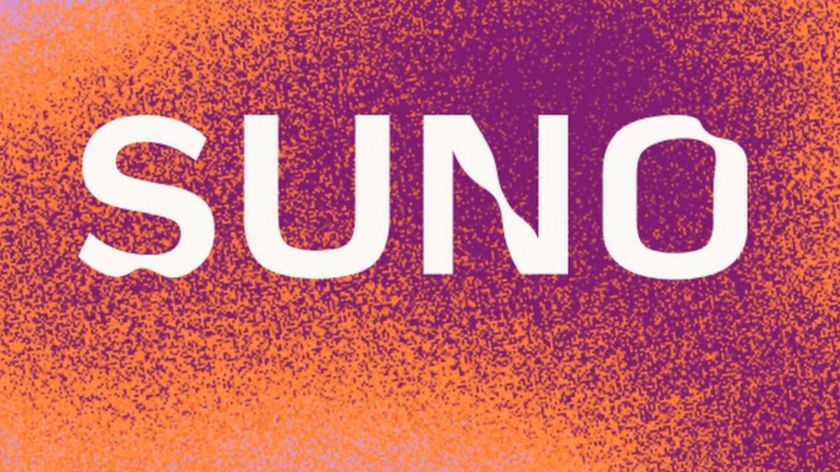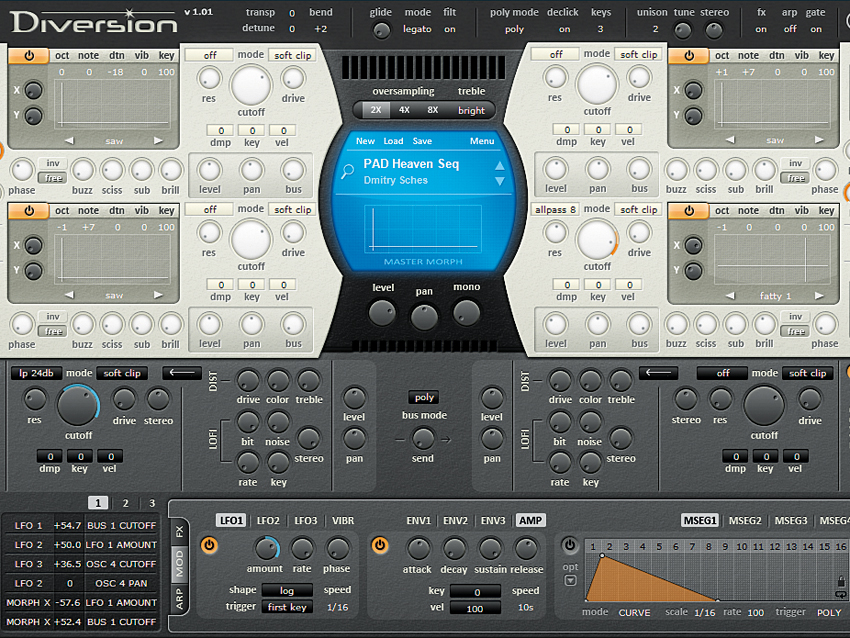MusicRadar Verdict
Recommended to preset lovers and hardcore sound designers alike, this is a great, thoroughly contemporary synth.
Pros
- +
Full feature-set, impeccable sound quality, plenty of ready-to-go presets, sounds incredibly modern, arguably unparalleled tonal controls, pushes current technology to the limits.
Cons
- -
Heavyweight system requirements.
MusicRadar's got your back

Dmitry Sches Diversion

Dmitry Sches Diversion

Dmitry Sches Diversion
Dmitry Sches is a software developer, musician, sound designer and self-confessed DSP lover hailing from Minsk in Belarus. Diversion is his debut release, and it's a super high-spec PC soft synth (an OS X version is in the works) aimed at producers of all electronic genres.
Be warned, though, for this is a synth designed to exploit the full power of modern computers; slowpoke systems will not get the job done. A dual-core CPU is the minimum requirement, but an Intel Core i5 or i7 processor is recommended. Flexibility and sound quality have been unashamedly placed much higher than CPU-friendliness in Sches' list of priorities, then.
"Diversion's overall sonic character has a slightly hard, edgy quality that excels at cutting through dense mixes thanks to its crystalline clarity."
Diversion's feature list is something of a synth programmer's wet dream. It all begins with the four oscillators, which each offer the same impressive list of waveforms - these range from basic to quirky.
Note that the waveforms are synthesised on the fly, as opposed to using wavetables. The benefits of this approach are mostly evident in the sound quality, which is exceptionally rich and pure.
Each oscillator also has X and Y timbre controls; the X control sounds like a high-pass filter, while the Y control sounds like an extra oscillator that's added one octave higher. As you can imagine, just these basic controls alone offer a gamut of possible sounds, but believe it or not, at this point we've barely scratched the surface of what Diversion can create…
Sonic chameleon
The four oscillators are arranged in pairs that can cross-modulate via FM and RM, so even though the oscillators offer your typical virtual analogue stuff, you can get all the classic grunts and screams of a digital synth, too. In fact, Diversion can pretty much do anything you could ask of it, sonically.
The oscillators are routed through twin buses that sport some of the most comprehensive multimode filters we've ever seen. They sound warm and silky out of the box, but if you're after a more rugged sound, the filters have a drive control with a variety of useful and interesting flavours to choose from.
Tonal control freak
We think that Diversion's greatest strength is the degree to which you can control its tonal qualities. Each of the four oscillators has its own filter with the same extensive feature set as the bus filters, including velocity sensitivity, key follow and multimode drive.
Our favourite filter type for shaping the oscillators is the Bell Comb filter - it's an unusual take on a comb effect that creates distinctly throaty textures when modulated.
Another tone-shaping feature that impressed us is the Oscillator Effects section (although the name is a little misleading, we reckon). It basically comprises four knobs that all modify some detail of that oscillator's waveform.
Under the oscilloscope, Buzz appears to add a rough, jagged edge to any waveform, giving lower notes more definition. The Scissor effect is like an unusual waveshaper that we found pleasantly unique and quite unpredictable.
Sub adds the sound of another oscillator an octave lower, while Brilliance sharpens the waveform edges, making the sound brighter. Combined with the Oscillator X and Y controls mentioned elsewhere, this feature means that you can adjust the tone of each Diversion patch to fit the mix you're working on without ever reaching for an EQ.
You'd be forgiven for feeling daunted at the prospect of getting started, but the layout and workflow are deceptively simple for a synth that's capable of so much. The interface is a fairly plain affair, designed to be intuitive and quick to use rather than frilly. Still, it manages to be easy on the eyes and far from ugly.
Easy come, good to go
You won't be disappointed with the included presets. The included Dmitry Sches library is over 200 patches strong and does a really good job of showing off the synth's sheer diversity.
That said, if we had to describe Diversion's overall sonic character, then we would say that it has a slightly hard, edgy quality that excels at cutting through dense mixes thanks to its crystalline clarity. It can certainly be made to sound soft and smooth, but by default, Diversion comes down more on the bold and rough side.
Incidentally, from early on, we were quite struck with how 'good to go' Diversion's patches are.
Almost paradoxically, we reckon that the advanced synthesis features will be of just as much benefit to the more casual user as they will to power users. This is because Diversion's extended feature-set enables the sound designer to program far more detail into the patches than in the average synth, meaning that there's less of a need for the end user to use insert effects on the output channel - plus, there's an arpeggiator and trance gate to get thecreative chi flowing.
Speaking of effects, a set of super-high-fidelity 'usual suspect' mixing processors is included, just in case you want to keep everything internal and take full advantage of the oversampling. There are four effects slots for each of the two buses and then a further four slots that cater for the mixed output.
If asked if there was anything missing from Diversion's effects list, we'd probably mention that we'd like to see a compressor. However, given what's on offer, that's probably quite a greedy request.
Modulation nation
Diversion's modulation matrix offers 18 slots, and when you see the extensive selection of modulation sources and destinations available, you can tell that Diversion was designed by a hardcore synthesist. If you just want to add a bit of animation to a patch, it's easy to dial in all the common combinations, such as LFO to filter cutoff, for example.
Moving past the many LFOs and envelopes, the next obvious modulation sources are Morph X and Morph Y, which enable you to assign the Master Morph to pretty much whatever you want. Remember that the Master Morph has MIDI learn, so if you want plenty of live performance expression, you're covered.
In summary, Diversion is definitely one of the best synths going for sound quality, usability and features. It will appeal to anyone who loves modern dance sounds, whether they intend toprogram their own from scratch or trawl through the list of beautiful and meticulously designed presets.
It can do a bit of everything, then, but it would be a little ambitious to expect your DAW to run more than a few instances of itin real-time, especially with the x4 or x8 oversampling engaged.
Hear the Dmitry Sches Diversion in action
Computer Music magazine is the world’s best selling publication dedicated solely to making great music with your Mac or PC computer. Each issue it brings its lucky readers the best in cutting-edge tutorials, need-to-know, expert software reviews and even all the tools you actually need to make great music today, courtesy of our legendary CM Plugin Suite.

“Stealing the work, art and livelihoods of lyricists, songwriters and composers”: Ivors Academy warns Suno AI over its ‘lyrics generator’

“I was like, ‘Man, I hated your band. You ended my thing’”: Bill Burr told Eddie Vedder that he hated Pearl Jam because they “knocked out” ‘80s hair metal
![James Hetfield [left] and Kirk Hammett harmonise solos as they perform live with Metallica in 1988. Hammett plays a Jackson Rhodes, Hetfield has his trusty white Explorer.](https://cdn.mos.cms.futurecdn.net/mpZgd7e7YSCLwb7LuqPpbi-840-80.jpg)
"I remember showing up at 10 or 11 in the morning and working on solos and that leading to two or three o’clock in the morning the next day”: How Metallica beat the clock and battled fatigue to create a poignant and pulverising anti-war epic










